Template:Featured article is only for Wikipedia:Featured articles.
State of Israel מְדִינַת יִשְׂרָאֵל (in Hebrew) Medīnat Yisrā'el دَوْلَةُ إِسْرَائِيلَ (in Arabic) Dawlat Isrā'īl | |
|---|---|
| Anthem: Hatikvah The Hope | |
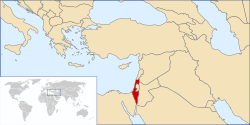 | |
| Capital | Jerusalem[a] 31°47′N 35°13′E / 31.783°N 35.217°E |
| Official languages | Hebrew, Arabic[1] |
| Ethnic groups | 75.4% Jewish, 20.6% Arab, 4% minority groups[2] |
| Demonym(s) | Israeli |
| Government | Parliamentary democracy[1] |
| Shimon Peres | |
| Benjamin Netanyahu | |
| Reuven Rivlin | |
| Dorit Beinisch | |
| Independence | |
| May 14, 1948 | |
| Area | |
• Total 1 | 20770⁄22072 km2 (0.36333 sq mi) (151st) |
• Water (%) | ~2% |
| Population | |
• 2009 estimate | 7,465,0002[3] (96th) |
• 1995 census | 5,548,523 |
• Density | 356.8/km2 (924.1/sq mi) (34th) |
| GDP (PPP) | 2008 estimate |
• Total | $202.562 billion[4] (50th) |
• Per capita | $28,473[4] (31st) |
| GDP (nominal) | 2009 estimate |
• Total | $215.727 billion[4] (39th) |
• Per capita | $29,671[4] (29th) |
| Gini (2005) | 38.6[1] Error: Invalid Gini value |
| HDI (2007) | Error: Invalid HDI value (27th) |
| Currency | Shekel (₪) (ILS or NIS) |
| Time zone | UTC+2 (IST) |
• Summer (DST) | UTC+3 (IDT) |
| Driving side | right |
| Calling code | 972 |
| ISO 3166 code | IL |
| Internet TLD | .il |
| |
Israel (Hebrew: יִשְׂרָאֵל, Yisra'el; Arabic: إِسْرَائِيلُ, Isrā'īl) officially the State of Israel (Hebrew: ⓘ, Medinat Yisra'el; Arabic: دَوْلَةُ إِسْرَائِيلَ, Dawlat Isrā'īl), is a country in Western Asia located on the eastern shore of the Mediterranean Sea. It borders Lebanon in the north, Syria in the northeast, Jordan in the east, and Egypt on the southwest, and contains geographically diverse features within its relatively small area.[6] Also adjacent are the West Bank to the east and Gaza Strip to the southwest. Israel is the world's only predominantly Jewish state[7] with a population of about 7.5 million people, of whom approximately 5.7 million are Jewish.[8][9] The largest ethnic minority group is the segment denominated as Arab citizens of Israel, while minority religious groups include Muslims, Christians, Druze, Samaritans, most of whom are found within the Arab segment.
The modern state of Israel has its historical and religious roots in the Biblical Land of Israel (Eretz Yisrael), a concept central to Judaism since ancient times,[10][11] and the heartland of the ancient kingdoms of Israel and Judah.[12] Following the birth of political Zionism in 1897 and the Balfour Declaration, the League of Nations granted the United Kingdom the British Mandate of Palestine after World War I, with responsibility for establishing "...such political, administrative and economic conditions as will secure the establishment of the Jewish national home, as laid down in the preamble, and the development of self-governing institutions, and also for safeguarding the civil and religious rights of all the inhabitants of Palestine, irrespective of race and religion..."[13]
In November 1947, the United Nations decided to partition Palestine into a Jewish state, an Arab state, and a UN-administered Jerusalem.[14] Partition was accepted by Zionist leaders but rejected by Arab leaders leading to the 1947–1948 Civil War in Mandatory Palestine. Israel declared independence on 14 May 1948 and neighboring Arab states attacked the next day. Since then, Israel has fought a series of wars with neighboring Arab states,[15] and in consequence controls territories beyond those delineated in the 1949 Armistice Agreements. Some international borders remain in dispute. Israel has signed peace treaties with Egypt and Jordan, though efforts to resolve conflict with the Palestinians have so far only met with limited success.
Israel is a developed country and a representative democracy with a parliamentary system and universal suffrage.[16][17] The Prime Minister serves as head of government and the Knesset serves as Israel's legislative body. The economy, based on the nominal gross domestic product, is the 44th-largest in the world.[18] Israel ranks highest among Middle Eastern countries on the UN Human Development Index.[19] Jerusalem is the country's capital[neutrality is disputed] and seat of government, while Israel's main financial center is Tel Aviv.[a]
Etymology
Over the past three thousand years, the name "Israel" has meant in common and religious usage both the Land of Israel and the entire Jewish nation.[20] According to the Bible, Jacob is renamed Israel after successfully wrestling with an angel of God.[21]
The earliest archaeological artifact to mention "Israel" (other than as a personal name) is the Merneptah Stele of ancient Egypt (dated the late 13th century BCE) which refers to a people of that name.[22] The modern country was named Medinat Yisrael, or the State of Israel, after other proposed names, including Eretz Israel ("the Land of Israel"), Zion, and Judea, were rejected.[23] In the early weeks of independence, the government chose the term "Israeli" to denote a citizen of Israel, with the formal announcement made by Minister of Foreign Affairs Moshe Sharett.[24]
History
Early roots
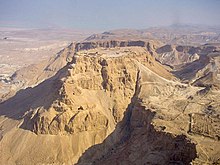
The Land of Israel, known in Hebrew as Eretz Yisrael, has been sacred to the Jewish people since Biblical times. According to the Torah, the Land of Israel was promised to the three Patriarchs of the Jewish people, by God, as their homeland;[25][26] scholars have placed this period in the early 2nd millennium BCE.[27] According to the traditional view, around the 11th century BCE, the first of a series of Israelite kingdoms and states established rule over the region; these Israelite kingdoms and states ruled intermittently for the following one thousand years.[28] The sites holiest to Judaism are located within Israel.
Between the time of the Israelite kingdoms and the 7th-century Muslim conquests, the Land of Israel fell under Assyrian, Babylonian, Persian, Greek, Roman, Sassanian, and Byzantine rule.[29][30] Jewish presence in the region dwindled after the failure of the Bar Kokhba revolt against the Roman Empire in 132 CE.[31] In 628/9, the Byzantine Emperor Heraclius conducted a massacre and expulsion of the Jews, at which point the Jewish population probably reached its lowest point. Nevertheless, a continuous Jewish presence in the Land of Israel remained.
Although the main Jewish population shifted from the Judea region to the Galilee,[32] the Mishnah and part of the Talmud, among Judaism's most important religious texts, were composed in Israel during this period.[33] The Land of Israel was captured from the Byzantine Empire around 636 CE during the initial Muslim conquests. Control of the region transferred between the Umayyads,[34] Abbasids,[35] and Crusaders over the next six centuries, before falling in the hands of the Mamluk Sultanate, in 1260. In 1516, the Land of Israel became a part of the Ottoman Empire, which ruled the region until the 20th century.[36]
Zionism and the British Mandate
| Part of a series on |
| Aliyah |
|---|
 |
| Concepts |
| Pre-Modern Aliyah |
| Aliyah in modern times |
| Absorption |
| Organizations |
| Related topics |
Jews living in the Diaspora have long aspired to return to Zion and the Land of Israel.[37] That hope and yearning was articulated in the Bible,[38] and is a central theme in the Jewish prayer book. Beginning in the 12th century, Catholic persecution of Jews led to a steady stream leaving Europe to settle in the Holy Land, increasing in numbers after Jews were expelled from Spain in 1492.[39] During the 16th century large communities struck roots in the Four Holy Cities, and in the second half of the 18th century, entire Hasidic communities from eastern Europe settled in the Holy Land.[40]

The first large wave of modern immigration, known as the First Aliyah (Hebrew: עלייה), began in 1881, as Jews fled pogroms in Eastern Europe.[41] While the Zionist movement already existed in theory, Theodor Herzl is credited with founding political Zionism,[42] a movement which sought to establish a Jewish state in the Land of Israel, by elevating the Jewish Question to the international plane.[43] In 1896, Herzl published Der Judenstaat (The State of the Jews), offering his vision of a future state; the following year he presided over the first World Zionist Congress.[44]
The Second Aliyah (1904–1914), began after the Kishinev pogrom. Some 40,000 Jews settled in Palestine but nearly half of them left.[41] Both the first and second waves of migrants were mainly Orthodox Jews,[45] but those in the Second Aliyah included socialist pioneers who established the kibbutz movement.[46] During World War I, British Foreign Secretary Arthur Balfour issued what became known as the Balfour Declaration, which "view[ed] with favour the establishment in Palestine of a national home for the Jewish people". At the request of Edwin Samuel Montagu and Lord Curzon, a line was also inserted stating "it being clearly understood that nothing shall be done which may prejudice the civil and religious rights of existing non-Jewish communities in Palestine, or the rights and political status enjoyed by Jews in any other country".[47]
The Jewish Legion, a group of battalions composed primarily of Zionist volunteers, assisted in the British conquest of Palestine. Arab opposition to the plan led to the 1920 Palestine riots and the formation of the Jewish organization known as the Haganah (meaning "The Defense" in Hebrew), from which the Irgun and Lehi split off.[48]In 1922, the League of Nations granted the United Kingdom a mandate over Palestine under terms similar to the Balfour Declaration.[49] The population of the area at this time was predominantly Muslim Arab, while the largest urban area in the region, Jerusalem, was predominantly Jewish.[50]
The Third (1919–1923) and Fourth Aliyah (1924–1929) brought 100,000 Jews to Palestine.[41]
The rise of Nazism in the 1930s led to the Fifth Aliyah, with an influx of a quarter of a million Jews. This caused the Arab revolt of 1936–1939 and led the British to cap immigration with the White Paper of 1939. With countries around the world turning away Jewish refugees fleeing the Holocaust, a clandestine movement known as Aliyah Bet was organized to bring Jews to Palestine.[41] By the end of World War II, Jews accounted for 33% of the population of Palestine, up from 11% in 1922.[51]
Independence and first years
After 1945 the United Kingdom became embroiled in an increasingly violent conflict with the Jews.[52] In 1947, the British government withdrew from commitment to the Mandate of Palestine, stating it was unable to arrive at a solution acceptable to both Arabs and Jews.[53] The newly created United Nations approved the UN Partition Plan (United Nations General Assembly Resolution 181) on November 29, 1947, dividing the country into two states, one Arab and one Jewish. Jerusalem was to be designated an international city — a corpus separatum — administered by the UN to avoid conflict over its status.[54]
The Jewish community accepted the plan,[55] but the Arab League and Arab Higher Committee rejected it.[56] On December 1, 1947 the Arab Higher Committee proclaimed a three-day strike, and Arab bands began attacking Jewish targets. Civil war began with the Jews initially on the defensive but gradually moving into offence. The Palestinian-Arab economy collapsed and 250,000 Palestinian-Arabs fled or were expelled.[57]
On May 14, 1948, the day before the end of the British Mandate, the Jewish Agency proclaimed independence, naming the country Israel; it was not until this day that the world knew that the new state would be called Israel.[58] The following day the armies of five Arab countries — Egypt, Syria, Jordan, Lebanon and Iraq — attacked Israel, launching the 1948 Arab-Israeli War.[59] Sudan, Yemen and Saudi Arabia also sent troops to assist the Arab contingent. After a year of fighting, a ceasefire was declared and temporary borders, known as the Green Line, were established.
Jordan annexed what became known as the West Bank and East Jerusalem, and Egypt took control of the Gaza Strip. Israel was admitted as a member of the United Nations on May 11, 1949.[60] During the conflict 711,000 Arabs, according to UN estimates, or about 80% of the previous Arab population, were expelled or fled the country.[61] The fate of the Palestinian refugees today is a major point of contention in the Israeli-Palestinian conflict.[62][63]
In the early years of the state, the Labor Zionist movement led by Prime Minister David Ben-Gurion dominated Israeli politics.[64][65] These years were marked by mass immigration of Holocaust survivors and an influx of Jews some of whom were persecuted in Arab lands. The population of Israel rose from 800,000 to two million between 1948 and 1958.[66] Most arrived as refugees with no possessions and were housed in temporary camps known as ma'abarot. By 1952, over 200,000 immigrants were living in these tent cities. The need to solve the crisis led Ben-Gurion to sign a reparations agreement with West Germany that triggered mass protests by Jews angered at the idea of Israel accepting financial compensation from Germany for the Holocaust genocide.[67]
During the 1950s Israel was frequently attacked by Palestinian fedayeen, mainly from the Egyptian-occupied Gaza Strip.[68] In 1956, Israel joined a secret alliance with the United Kingdom and France aimed at recapturing the Suez Canal, which the Egyptians had nationalized (see the Suez Crisis). Despite capturing the Sinai Peninsula, Israel was forced to retreat due to pressure from the United States and the Soviet Union in return for guarantees of Israeli shipping rights in the Red Sea and the Canal.[69]
At the start of the following decade, Israel captured Adolf Eichmann, an architect of the Final Solution hiding in Argentina, and brought him to trial.[70] The trial had a major impact on public awareness of the Holocaust,[71] and to date Eichmann remains the only person ever executed by civil authorities in Israel.[72]
Conflicts and peace treaties
Arab nationalists led by Nasser refused to recognize Israel or its right to exist, calling for its destruction.[73] In 1967, Egypt, Syria, and Jordan massed troops close to Israeli borders, expelled UN peacekeepers and blocked Israel's access to the Red Sea. Israel saw these actions as a casus belli for a pre-emptive strike that launched the Six-Day War, in which Israel achieved a decisive victory and captured the West Bank, Gaza Strip, Sinai Peninsula and Golan Heights.[74] The 1949 Green Line became the administrative boundary between Israel and the occupied territories. Jerusalem's boundaries were enlarged, incorporating East Jerusalem. The Jerusalem Law, passed in 1980, reaffirmed this measure and reignited international controversy over the status of Jerusalem. The position of the majority of UN member states is reflected in numerous resolutions which say that any actions taken by Israel to impose its laws, jurisdiction and administration on Jerusalem are illegal and have no validity whatsoever.[75]
The failure of the Arab states in the 1967 war led to the rise of Arab non-state actors in the conflict, most importantly the Palestinian Liberation Organization (PLO) which was committed to what it called "armed struggle as the only way to liberate the homeland".[76][77] In the late 1960s and early 1970s, Palestinian groups launched a wave of attacks[78] against Israeli targets around the world,[79] including a massacre of Israeli athletes at the 1972 Summer Olympics. Israel responded with Operation Wrath of God, in which those responsible for the Munich massacre were tracked down and assassinated.[80] From 1969 to 1970, Israel fought the War of Attrition against Egypt.[81]
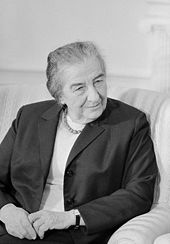
On October 6, 1973, Yom Kippur, the holiest day in the Jewish calendar, the Egyptian and Syrian armies launched a surprise attack against Israel. The war ended on October 26 with Israel successfully repelling Egyptian and Syrian forces but suffering great losses.[82] An internal inquiry exonerated the government of responsibility for the war, but public anger forced Prime Minister Golda Meir to resign.
The 1977 Knesset elections marked a major turning point in Israeli political history as Menachem Begin's Likud party took control from the Labor Party.[83] Later that year, Egyptian President Anwar El Sadat made a trip to Israel and spoke before the Knesset in what was the first recognition of Israel by an Arab head of state.[84] In the two years that followed, Sadat and Menachem Begin signed the Camp David Accords and the Israel-Egypt Peace Treaty.[85] Israel withdrew from the Sinai Peninsula and agreed to enter negotiations over an autonomy for Palestinians across the Green Line, a plan which was never implemented. Begin's government encouraged Israelis to settle in the West Bank, leading to friction with the Palestinians in those areas.
On June 7, 1981, Israel heavily bombed Iraq's Osirak nuclear reactor in Operation Opera, disabling it. Israeli intelligence had suspected Iraq was intending to use it for weapons development. In 1982, Israel intervened in the Lebanese Civil War to destroy the bases from which the Palestine Liberation Organization launched attacks and missiles at northern Israel. That move developed into the First Lebanon War.[86] Israel withdrew from most of Lebanon in 1986, but maintained a borderland buffer zone until 2000. The First Intifada, a Palestinian uprising against Israeli rule,[87] broke out in 1987 with waves of violence occurring in the occupied territories. Over the following six years, more than a thousand people were killed in the ensuing violence, much of which was internal Palestinian violence.[88] During the 1991 Gulf War, the PLO and many Palestinians supported Saddam Hussein and Iraqi missile attacks against Israel.[89][90]
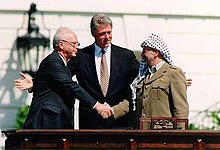
In 1992, Yitzhak Rabin became Prime Minister following an election in which his party promoted compromise with Israel's neighbors.[91][92] The following year, Shimon Peres and Mahmoud Abbas, on behalf of Israel and the PLO, signed the Oslo Accords, which gave the Palestinian National Authority the right to self-govern parts of the West Bank and the Gaza Strip.[93] A declared intent was recognition of Israel's right to exist and an end to terrorism.[94] In 1994, the Israel-Jordan Treaty of Peace was signed, making Jordan the second Arab country to normalize relations with Israel.[95]
Arab public support for the Accords was damaged by the Cave of the Patriarchs massacre, continuation of settlements,[96] and checkpoints, and the deterioration of economic conditions. Israeli public support for the Accords waned as Israel was struck by Palestinian suicide attacks. While leaving a peace rally in November 1995, Yitzhak Rabin was assassinated by a far-right-wing Jew who opposed the Accords. The country was shocked.
At the end of the 1990s, Israel, under the leadership of Benjamin Netanyahu, withdrew from Hebron,[97] and signed the Wye River Memorandum, giving greater control to the Palestinian National Authority.[98]
Ehud Barak, elected Prime Minister in 1999, began the new millennium by withdrawing forces from Southern Lebanon and conducting negotiations with Palestinian Authority Chairman Yasser Arafat and U.S. President Bill Clinton at the July 2000 Camp David Summit. During the summit, Barak offered a plan for the establishment of a Palestinian state, but Yasser Arafat rejected it.[99] After the collapse of the talks, the Second Intifada began.
Ariel Sharon became the new prime minister in a 2001 special election. During his tenure, Sharon carried out his plan to unilaterally withdraw from the Gaza Strip and also spearheaded the construction of the Israeli West Bank barrier.[100] In July 2006, a Hezbollah artillery assault on Israel's northern border communities and a cross border abduction of two Israeli soldiers sparked the month long Second Lebanon War.[101][102]
In May 2008, Israel confirmed it had been discussing a peace treaty with Syria for a year, with Turkey as a go-between.[103] At the end of 2008 a ceasefire between Hamas and Israel collapsed, hostilities broke out marking the start of the three-week Gaza War.[104] In January, Israel announced a unilateral ceasefire, conditional on elimination of further rocket and mortar attacks from Gaza, and began withdrawing over the next several days.[105] Hamas announced its own ceasefire, with its own conditions of complete withdrawal and opening of border crossings. Despite neither the Qassam launchings nor Israeli retaliatory strikes having completely stopped, the fragile ceasefire remained in order.[106]
Geography and climate
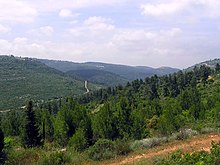
Israel is located at the eastern end of the Mediterranean Sea, bounded by Lebanon to the north, Syria to the northeast, Jordan to the east, and Egypt to the southwest. The sovereign territory of Israel, excluding all territories captured by Israel during the 1967 Six-Day War, is approximately 20,770 square kilometers (8,019 sq mi) in area, of which two percent is water.[1] The total area under Israeli law, including East Jerusalem and the Golan Heights, is 22,072 square kilometers (8,522 sq mi).[107]
The total area under Israeli control, including the military-controlled and partially Palestinian-governed territory of the West Bank, is 27,799 square kilometers (10,733 sq mi).[108]

Despite its small size, Israel is home to a variety of geographic features, from the Negev desert in the south to the mountain ranges of the Galilee, Carmel, and the Golan in the north. The Israeli Coastal Plain on the shores of the Mediterranean is home to seventy percent of the nation's population.East of the central highlands lies the Jordan Rift Valley, which forms a small part of the 6,500-kilometer (4,040-mi) Great Rift Valley. The Jordan River runs along the Jordan Rift Valley, from Mount Hermon through the Hulah Valley and the Sea of Galilee to the Dead Sea, the lowest point on the surface of the Earth.[109] Further south is the Arabah, ending with the Gulf of Eilat, part of the Red Sea.

Unique to Israel and the Sinai Peninsula are makhteshim, or erosion cirques.[110] The largest makhtesh in the world is Ramon Crater in the Negev,[111] which measures 40 kilometers by 8 kilometers (25 mi by 5 mi).[112] A report on the environmental status of the Mediterranean basin states that Israel has the largest number of plant species per square meter of all the countries in the basin.[113]
Temperatures in Israel vary widely, especially during the winter. The more mountainous regions can be windy, cold, and sometimes snowy; Jerusalem usually receives at least one snowfall each year.[114] Meanwhile, coastal cities, such as Tel Aviv and Haifa, have a typical Mediterranean climate with cool, rainy winters and long, hot summers. The highest temperature in the continent of Asia (53.7°C or 129°F) was recorded in 1942 at Tirat Zvi kibbutz in the northern parts of the Jordan-valley.[115] From May to September, rain in Israel is rare.[116][117] With scarce water resources, Israel has developed various water-saving technologies, including drip irrigation.[118] Israelis also take advantage of the considerable sunlight available for solar energy, making Israel the leading nation in solar energy use per capita.[119]
Government and politics

Israel operates under a parliamentary system as a democratic republic with universal suffrage.[1] The President of Israel is the head of state, but his duties are limited and largely ceremonial.[120] A Parliament Member supported by a majority in parliament becomes the Prime Minister, usually the chairman of the largest party. The Prime Minister is the head of government and head of the Cabinet.[120][121] Israel is governed by a 120-member parliament, known as the Knesset. Membership in the Knesset is based on proportional representation of political parties,[122] with a 2% electoral threshold, which commonly results in coalition governments.
Parliamentary elections are scheduled every four years, but unstable coalitions or a no-confidence vote by the Knesset often dissolves governments earlier. "The average life span of an Israeli government is 22 months. The peace process, the role of religion in the state, and political scandals have caused coalitions to break apart or produced early elections."[123] The Basic Laws of Israel function as an unwritten constitution. In 2003, the Knesset began to draft an official constitution based on these laws.[1][124]


Israel has a three-tier court system. At the lowest level are magistrate courts, situated in most cities across the country. Above them are district courts, serving both as appellate courts and courts of first instance; they are situated in five of Israel's six districts. The third and highest tier in Israel is the Supreme Court, seated in Jerusalem. It serves a dual role as the highest court of appeals and the High Court of Justice. In the latter role, the Supreme Court rules as a court of first instance, allowing individuals, both citizens and non-citizens, to petition against decisions of state authorities.[125][126] Israel is not a member of the International Criminal Court blaming what it sees as the potential for political bias.[127]
Israel's legal system combines English common law, civil law, and Jewish law.[1] It is based on the principle of stare decisis (precedent) and is an adversarial system, where the parties in the suit bring evidence before the court. Court cases are decided by professional judges rather than juries.[125] Marriage and divorce are under the jurisdiction of the religious courts: Jewish, Muslim, Druze, and Christian. A committee of Knesset members, Supreme Court justices, and Israeli Bar members carries out the election of judges.[128]
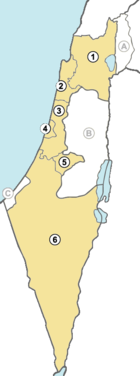
Basic Law: Human Dignity and Liberty seeks to defend human rights and liberties in Israel. Israel is the only country in the region ranked "Free" by Freedom House based on the level of civil liberties and political rights; the "Israeli Occupied Territories/Palestinian Authority" was ranked "Not Free."[129][130] Similarly, Reporters Without Borders rated Israel 93 out of 175 countries in terms of freedom of the press, lagging behind countries such as Kuwait (60th), Lebanon (61st) and United Arab Emirates (86th).[131][132] Nevertheless, groups such as Amnesty International[133] and Human Rights Watch[134] have often disapproved of Israel's human rights record in regards to the Arab-Israeli conflict. Israel's civil liberties also allow for self-criticism, from groups such as B'Tselem, an Israeli human rights organization.[135]
Administrative districts
The State of Israel is divided into six main administrative districts, known as mehozot (מחוזות; singular: mahoz) – Center, Haifa, Jerusalem, North, Southern, and Tel Aviv Districts. Districts are further divided into fifteen sub-districts known as nafot (נפות; singular: nafa), which are themselves partitioned into fifty natural regions.[136]
For statistical purposes, the country is divided into three metropolitan areas: Tel Aviv metropolitan area (population 3,206,400), Haifa metropolitan area (population 1,021,000), and Beer Sheva metropolitan area (population 559,700).[137] Israel's largest municipality, both in population and area,[138] is Jerusalem with 732,100 residents in an area of 126 square kilometers (49 sq mi). Israeli government statistics on Jerusalem include the population and area of East Jerusalem, which is widely recognized as part of the Palestinian territories under Israeli occupation.[139] Tel Aviv, Haifa, and Rishon LeZion rank as Israel's next most populous cities, with populations of 384,600, 267,000, and 222,300 respectively.[140]
Occupied territories
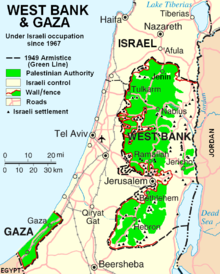
In 1967, as a result of the Six-Day War, Israel gained control of the West Bank, East Jerusalem, the Gaza strip and the Golan Heights. Israel also took control of the Sinai Peninsula, but returned it to Egypt as part of the 1979 Israel-Egypt Peace Treaty.
Following Israel's capture of these territories, settlements consisting of Israeli citizens were established within each of them. Israel has applied civilian law to the Golan Heights and East Jerusalem, incorporating them into its territory and offering their inhabitants permanent residency status and the possibility to become full citizen if they asked it. In contrast, the West Bank has remained under military occupation, and it and the Gaza Strip are seen by the Palestinians and most of the international community as the site of a future Palestinian state[141]. The UN Security Council has declared the incorporations of the Golan Heights and East Jerusalem to be "null and void" and continues to view the territories as occupied.[142]
The status of East Jerusalem in any future peace settlement has at times been a difficult hurdle in negotiations between Israeli governments and representatives of the Palestinians. Most negotiations relating to the territories have been on the basis of United Nations Security Council Resolution 242, which calls on Israel to withdraw from occupied territories in return for normalization of relations with Arab states, a principle known as "Land for peace".[143][144][145]
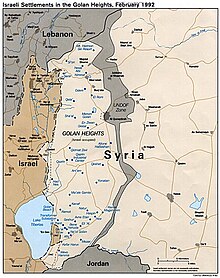
The West Bank was annexed by Jordan in 1948, following the Arab rejection of the UN decision to create two states in Palestine. Only Britain recognized this annexation and Jordan has since ceded its claim to the territory to the PLO. The West Bank was occupied by Israel in 1967. The population are mainly Arab Palestinians, including refugees of the 1948 Arab-Israeli War.[146] From their occupation in 1967 until 1993, the Palestinians living in these territories were under Israeli military administration. Since the Israel-PLO letters of recognition, most of the Palestinian population and cities have been under the internal jurisdiction of the Palestinian Authority, and only partial Israeli military control, although Israel has on several occasions redeployed its troops and reinstated full military administration during periods of unrest. In response to increasing attacks as part of the Second Intifada, the Israeli government started to construct the Israeli West Bank barrier,[147] which is partially built within the West Bank.[148]
The Gaza strip was occupied by Egypt from 1948 to 1967 and then by Israel from 1967 to 2005. In 2005, as part of Israel's unilateral disengagement plan, Israel removed all of its residents and forces from the territory. However, Israel still controls Gaza's airspace and sea access and has on occasion sent troops into the area.[149] Gaza has a border with Egypt and an agreement between Israel, the EU, the PA and Egypt governed how border crossing would take place (it was monitored by European observers),[150] However the election of a Hamas government has led to problems in implementing it resulting in the border crossing being closed much of the time.[151] Inner control of Gaza is in the hands of the Hamas government.
Foreign relations
Israel maintains diplomatic relations with 161 countries and has 94 diplomatic missions around the world.[152] Only three members of the Arab League have normalized relations with Israel; Egypt and Jordan signed peace treaties in 1979 and 1994, respectively, and Mauritania opted for full diplomatic relations with Israel in 1999. Two other members of the Arab League, Morocco and Tunisia, which had some diplomatic relations with Israel, severed them at the start of the Second Intifada in 2000.[153] Since 2003, ties with Morocco have been improved, and Israel's foreign minister has visited the country.[154]
As a result of the 2009 Gaza War, Mauritania, Qatar, Bolivia, and Venezuela suspended political and economical ties with Israel.[155][156] Under Israeli law, Lebanon, Syria, Saudi Arabia, Iraq, and Yemen are enemy countries[157] and Israeli citizens may not visit them without permission from the Ministry of the Interior.[158] Since 1995, Israel has been a member of the Mediterranean Dialogue, which fosters cooperation between seven countries in the Mediterranean Basin and the members of the North Atlantic Treaty Organization.[159]
Foreign relations with United States, Turkey, Germany, the United Kingdom and India are among Israel's strongest. The United States was the first country to recognize the State of Israel, followed by the Soviet Union. The United States may regard Israel as its primary ally in the Middle East, based on "common democratic values, religious affinities, and security interests".[160] Their bilateral relations are multidimensional and the United States is the principal proponent of the Arab-Israeli peace process. U.S. and Israeli views differ on some issues, such as the Golan Heights, Jerusalem, and settlements.[161]
Although Turkey and Israel did not establish full diplomatic relations until 1991,[162] Turkey has cooperated with the State since its recognition of Israel in 1949. Turkey's ties to the other Muslim-majority nations in the region have at times resulted in pressure from Arab states to temper its relationship with Israel.[163] Relations between Turkey and Israel took a downturn, however, after the former's condemnation of Israel after the 2009 Gaza War.[155]
Germany's strong ties with Israel include cooperation on scientific and educational endeavors and the two states remain strong economic and military partners.[164][165] India established full diplomatic ties with Israel in 1992 and has fostered a strong military and cultural partnership with the country since then.[166] The UK has kept full diplomatic relations with Israel since its formation having had two visits from heads of state in 2007. Relations between the two countries were also made stronger by former prime minister Tony Blair's efforts for a two state resolution. The UK is seen as having a "natural" relationship with Israel on account of the British Mandate of Palestine.[167] Iran had diplomatic relations with Israel under the Pahlavi dynasty[168] but withdrew its recognition of Israel during the Iranian Revolution.[169]
Military



The Israel Defense Forces consists of the Israeli Army, Israeli Air Force and Israeli Navy. It was founded during the 1948 Arab-Israeli War by consolidating paramilitary organizations – chiefly the Haganah – that preceded the establishment of the state.[170] The IDF also draws upon the resources of the Military Intelligence Directorate (Aman), which works with the Mossad and Shabak.[171] The Israel Defense Forces has been involved in several major wars and border conflicts in its short history, making it one of the most battle-trained armed forces in the world.[172][173]
The majority of Israelis are drafted into the military at the age of eighteen. Men serve three years and women serve two years.[174] Following compulsory service, Israeli men join the reserve forces and do several weeks of reserve duty every year until their forties. Most women are exempt from reserve duty. Arab citizens of Israel (except the Druze) and those engaged in full-time religious studies are exempt from military service, although the exemption of yeshiva students has been a source of contention in Israeli society for many years.[175][176] An alternative for those who receive exemptions on various grounds is Sherut Leumi, or national service, which involves a program of service in hospitals, schools and other social welfare frameworks.[177] As a result of its conscription program, the IDF maintains approximately 168,000 active troops and an additional 408,000 reservists.[178]
The nation's military relies heavily on high-tech weapons systems designed and manufactured in Israel as well as some foreign imports. The United States is a particularly notable foreign contributor; they are expected to provide the country with $30 billion in military aid between 2008 and 2017.[179] The Israeli- and U.S.-designed Arrow missile is one of the world's only operational anti-ballistic missile systems.[180] Since the Yom Kippur War, Israel has developed a network of reconnaissance satellites.[181] The success of the Ofeq program has made Israel one of seven countries capable of launching such satellites.[182] The country has also developed its own main battle tank, the Merkava. Since its establishment, Israel has spent a significant portion of its gross domestic product on defense. In 1984, for example, the country spent 24%[183] of its GDP on defense. Today, that figure has dropped to 7.3%.[1]
Israel is widely believed to possess nuclear weapons.[184] However, Israel has not signed the Nuclear Non-Proliferation Treaty and maintains a policy of deliberate ambiguity toward its nuclear capabilities.
After the Gulf War in 1991, when Israel was attacked by Iraqi Scud missiles, a law was passed requiring all apartments and homes in Israel to have a mamad, a reinforced security room impermeable to chemical and biological substances.[185]
Economy
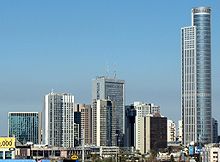
Israel is considered one of the most advanced countries in Southwest Asia in economic and industrial development. The country is ranked 3rd in the region on the World Bank's Ease of Doing Business Index[186] as well as in the World Economic Forum's Global Competitiveness Report.[187] It has the second-largest number of startup companies in the world (after the United States) and the largest number of NASDAQ-listed companies outside North America.[188]
In 2007, Israel had the 44th-highest gross domestic product and 22nd-highest gross domestic product per capita (at purchasing power parity) at US$232.7 billion and US$33, 299, respectively.[189] In 2007, Israel was invited to join the Organisation for Economic Co-operation and Development,[190] which promotes cooperation between countries that adhere to democratic principles and operate free market economies.[191] Subsequently the New Israeli Shekel was announced as one of 17 freely convertible currencies according to the CLS list.[192][193]
Despite limited natural resources, intensive development of the agricultural and industrial sectors over the past decades has made Israel largely self-sufficient in food production, apart from grains and beef. Other major imports to Israel, totaling US$47.8 billion in 2006, include fossil fuels, raw materials, and military equipment.[1] Leading exports include fruits, vegetables, pharmaceuticals, software, chemicals, military technology, and diamonds; in 2006, Israeli exports reached US$42.86 billion.[1]
Israel is a global leader in water conservation and geothermal energy,[194] and its development of cutting-edge technologies in software, communications and the life sciences have evoked comparisons with Silicon Valley.[195][196] Intel[197] and Microsoft[198] built their first overseas research and development centers in Israel, and other high-tech multi-national corporations, such as IBM, Cisco Systems, and Motorola, have opened facilities in the country. In July 2007, U.S. billionaire Warren Buffett's Berkshire Hathaway bought an Israeli company Iscar, its first non-U.S. acquisition, for $4 billion.[199] Since the 1970s, Israel has received economic aid from the United States, whose loans account for the bulk of Israel's external debt.[1] In 2007, the United States approved another $30 billion in aid to Israel over the next ten years.[179]
Tourism, especially religious tourism, is another important industry in Israel, with the country's temperate climate, beaches, archaeological and historical sites, and unique geography also drawing tourists. Israel's security problems have taken their toll on the industry, but the number of incoming tourists is on the rebound.[200] In 2008, over 3 million tourists visited Israel.[201]
Transportation
Israel has 18,096 km of paved roads,[202] and 2.4 million motor vehicles.[203] The number of motor vehicles per 1,000 persons was 324, relatively low with respect to developed countries.[203] Israel has 5,715 buses on scheduled routes,[204] operated by several carriers, the largest of which is Egged, serving most of the country. Railways stretch across 949 km and are operated solely by government-owner Israel Railways[205] (All figures are for 2008). Following major investments beginning in the early-to-mid 1990s, the number of train passengers per year has grown from 2.5 million in 1990, to 35 million in 2008; railways are also used to transport 6.8 million tons of cargo, per year.[205]
Israel is served by two international airports, the large Ben Gurion International Airport near Tel Aviv-Yafo, and the significantly smaller Ovda Airport, in the country's southern region, as well as several smaller domestic airports.[206] Airports served 11.1 million passengers (entries and departures) in 2008, 11 million of which through Ben Gurion airport.[207][208]
On the Mediterranean coast, Haifa Port is the country's oldest and largest port, while Ashdod Port is one of the few deep water ports in the world built on the open sea.[206] In addition to these, the smaller Port of Eilat is situated on the Red Sea, and is used mainly for trading with Far East countries.
Science and education
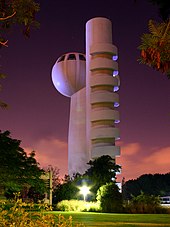
Israel has the highest school life expectancy in Southwest Asia, and is tied with Japan for second-highest school life expectancy on the Asian continent (after South Korea).[209] Israel similarly has the highest literacy rate in Southwest Asia, according to the United Nations.[210] The State Education Law, passed in 1953, established five types of schools: state secular, state religious, ultra orthodox, communal settlement schools, and Arab schools. The public secular is the largest school group, and is attended by the majority of Jewish and non-Arab pupils in Israel. Most Arabs send their children to schools where Arabic is the language of instruction[211].
Education is compulsory in Israel for children between the ages of three and eighteen.[212][213] Schooling is divided into three tiers – primary school (grades 1–6), middle school (grades 7–9), and high school (grades 10–12) – culminating with Bagrut matriculation exams. Proficiency in core subjects such as mathematics, Bible, Hebrew language, Hebrew and general literature, English, history, and civics is necessary to receive a Bagrut certificate.[214] In Arab, Christian and Druze schools, the exam on Biblical studies is replaced by an exam in Islam, Christianity or Druze heritage.[215] In 2003, over half of all Israeli twelfth graders earned a matriculation certificate.[216]

Israel's eight public universities are subsidized by the state.[214][218] The Hebrew University of Jerusalem, Israel's oldest university, houses the Jewish National and University Library, the world's largest repository of books on Jewish subjects.[219] The Hebrew University is consistently ranked among world's 100 top universities[220][221] by the prestigious ARWU academic ranking. Other major universities in the country include the Technion, the Weizmann Institute of Science, Tel Aviv University (TAU), Bar-Ilan University, the University of Haifa, and Ben-Gurion University of the Negev. Israel's seven research universities (excluding the Open University) are consistently ranked among top 500 in the world.[222] Israel ranks third in the world in the number of academic degrees per capita (20 percent of the population).[223][224] Israel has produced five Nobel Prize-winning scientists since 2002[225] and publishes among the most scientific papers per capita of any country in the world.[226][227]
Israel leads world in stem cell research papers per capita since 2000[228] In addition, Israeli universities are among 100 top world universities in mathematics (TAU, Hebrew University and Technion), physics (TAU, Hebrew University and Weizmann Institute of Science), chemistry (TAU, Hebrew University and Technion), computer science (TAU, Hebrew University, Weizmann Institute of Science, BIU and Technion) and economics (TAU and Hebrew University).[229]
In 2009 Israel was ranked 2nd among 20 top countries in space sciences by Thomson Reuters agency.[230] Since 1988 Israel Aerospace Industries have indigenously designed and built at least 12 commercial and spy satellites. Most were launched to orbit from Israeli air force base "Palmachim" by the Shavit space launch vehicle. Some of Israel's satellites are ranked among the world's most advanced space systems.[231] In 2003, Ilan Ramon became Israel's first astronaut, serving as payload specialist of STS-107, the fatal mission of the Space Shuttle Columbia.
Israel has embraced solar energy, its engineers are on the cutting edge of solar energy technology[232] and its solar companies work on projects around the world.[233][234] Over 90% of Israeli homes use solar energy for hot water, the highest per capita in the world.[235][236] According to government figures, the country saves 8% of its electricity consumption per year because of its solar energy use in heating.[237] The high annual incident solar irradiance at its geographic latitude creates ideal conditions for what is an internationally renowned solar research and development industry in the Negev Desert.[232][233][234]
Demographics
As of 2008, Israel's population is 7.28 million.[238] Israel has two official languages, Hebrew and Arabic.[1] Hebrew is the primary language of the state and is spoken by the majority of the population. Arabic is spoken by the Arab minority and Jews who immigrated to Israel from Arab lands (by 2002 these Jews and their descendants constituted about 40% of Israel's population).[239] As of 2008, Arab citizens of Israel comprise just over 20% of the country's total population.[240]
Many Israelis can communicate reasonably well in English, as many television programs are in English and many schools teach English at early grades (no later than the 4th grade, according to the official curriculum). As a country of immigrants, many languages can be heard on the streets of Israel. A large influx of people from the former Soviet Union and Ethiopia (some 120,000 Ethiopian Jews live in Israel)[241] have made Russian and Amharic widely spoken in Israel.[242] Between 1990 and 1994, the immigration of Jews from the former Soviet Union increased Israel's population by twelve percent.[243] Out of more than one million Russian-speaking immigrants in Israel,[244] about 300,000 are not Jewish.[245]
Over the last decade, immigration flows have also included significant numbers of workers from countries such as Romania, Thailand, China, and a number of countries in Africa and South America; gauging precise numbers is difficult because of the presence of "undocumented" immigrants,[246] but estimates run in the region of 200,000.[247] Over 16,000 African asylum seekers have entered Israel in recent years.[248]
Retention of Israel's population since 1948 is about even or greater, when compared to other countries with mass immigration.[249] Emigration from Israel (yerida) to other countries, primarily the United States and Canada, is described by demographers as modest,[250] but is often cited by Israeli government ministries as a major threat to Israel's future.[251][252]
As of 2009 over 300,000 Israeli citizens live in the West Bank settlements[253][254] such as Ma'ale Adumim and Ariel, and communities that predated the establishment of the State but were re-established after the Six-Day War, in cities such as Hebron and Gush Etzion. 18,000 Israelis live in the Golan Heights.[255] In 2006, there were 250,000 Jews living in East Jerusalem.[256] The total number of Israeli settlers is over 500,000 (6.5 % of the Israeli population). Approximately 7,800 Israelis lived in settlements in the Gaza Strip until they were evacuated by the government as part of its 2005 disengagement plan.[257]
Religion
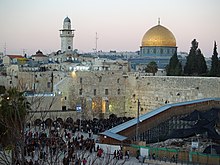
Israel was established as a homeland for the Jewish people and is often referred to as the Jewish state. The country's Law of Return grants all Jews and those of Jewish lineage the right to Israeli citizenship.[258] Just over three quarters, or 75.5%, of the population are Jews from a diversity of Jewish backgrounds. Approximately 68% of Israeli Jews are Israeli-born, 22% are immigrants from Europe and the Americas, and 10% are immigrants from Asia and Africa (including the Arab World).[259] The religious affiliation of Israeli Jews varies widely: 55% say they are "traditional," while 20% consider themselves "secular Jews," 17% define themselves as "Orthodox Jews"; the final 8% define themselves as "Haredi Jews."[260]

Making up 16% of the population, Muslims constitute Israel's largest religious minority. About 2% of the population are Christian and 1.5% are Druze.[261] The Christian population includes both Arab Christians and Messianic Jews.[262] Members of many other religious groups, including Buddhists and Hindus, maintain a presence in Israel, albeit in small numbers.[263]
The city of Jerusalem is of special importance to Jews, Muslims and Christians as it is the home of sites that are pivotal to their religious beliefs, such as the Israeli-controlled Old City that incorporates the Western Wall and the Temple Mount, the Al-Aqsa Mosque and the Church of the Holy Sepulchre. Other landmarks of religious importance are located in the West Bank, among them Joseph's tomb in Shechem, the birthplace of Jesus and Rachel's Tomb in Bethlehem, and the Cave of the Patriarchs in Hebron.
The administrative center of the Bahá'í Faith and the Shrine of the Báb are located at the Bahá'í World Centre in Haifa and the leader of the faith is buried in Acre. Apart from maintenance staff, there is no Bahá'í community in Israel, although it is a destination for pilgrimages. Bahá'í staff in Israel do not teach their faith to Israelis following strict policy.[264][265]
Languages

Official languages are Hebrew and Arabic. However, much official signage is also in English. Since November 2009 it has been debated whether to allow company filings to be submitted in English in order to allow the easier promotion of international business.[266]
The main language amongst the Deaf Israelis is Israeli Sign Language (ISL). The Al-Sayyid Bedouin Sign Language (ABSL) is another major sign language used by about 150 Deaf and many hearing members of the al-Sayyid Bedouin tribe in the Negev desert of southern Israel.
Culture
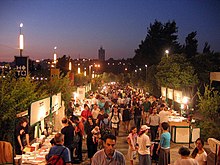
Israel's diverse culture stems from the diversity of the population: Jews from around the world have brought their cultural and religious traditions with them, creating a melting pot of Jewish customs and beliefs.[267] Israel is the only country in the world where life revolves around the Hebrew calendar. Work and school holidays are determined by the Jewish holidays, and the official day of rest is Saturday, the Jewish Sabbath.[268] Israel's substantial Arab minority has also left its imprint on Israeli culture in such spheres as architecture,[269] music,[270] and cuisine.[271]
Israeli literature is primarily poetry and prose written in Hebrew, as part of the renaissance of Hebrew as a spoken language since the mid-19th century, although a small body of literature is published in other languages, such as English. By law, two copies of all printed matter published in Israel must be deposited in the Jewish National and University Library at the Hebrew University of Jerusalem. In 2001, the law was amended to include audio and video recordings, and other non-print media.[272] In 2006, 85 percent of the 8, 000 books transferred to the library were in Hebrew.[273] The Hebrew Book Week (He: שבוע הספר) is held each June and features book fairs, public readings, and appearances by Israeli authors around the country. During the week, Israel's top literary award, the Sapir Prize, is presented. In 1966, Shmuel Yosef Agnon shared the Nobel Prize in Literature with German Jewish author Nelly Sachs.[274]

Israeli music contains musical influences from all over the world; Sephardic music, Hasidic melodies, Belly dancing music, Greek music, jazz, and pop rock are all part of the music scene.[275][276] The nation's canonical folk songs, known as "Songs of the Land of Israel," deal with the experiences of the pioneers in building the Jewish homeland.[277] Among Israel's world-renowned[278] orchestras is the Israel Philharmonic Orchestra, which has been in operation for over seventy years and today performs more than two hundred concerts each year.[279] Israel has also produced many musicians of note, some achieving international stardom. Itzhak Perlman, Pinchas Zukerman and Ofra Haza are among the internationally acclaimed musicians born in Israel. Israel has participated in the Eurovision Song Contest nearly every year since 1973, winning the competition three times and hosting it twice.[280] Eilat has hosted its own international music festival, the Red Sea Jazz Festival, every summer since 1987.[281]
Continuing the strong theatrical traditions of the Yiddish theater in Eastern Europe, Israel maintains a vibrant theatre scene. Founded in 1918, Habima Theatre in Tel Aviv is Israel's oldest repertory theater company and national theater.[282]
The Israel Museum in Jerusalem is one of Israel's most important cultural institutions[283] and houses the Dead Sea scrolls,[284] along with an extensive collection of Judaica and European art.[283] Israel's national Holocaust museum, Yad Vashem, houses the world's largest archive of Holocaust-related information.[285] Beth Hatefutsoth (the Diaspora Museum), on the campus of Tel Aviv University, is an interactive museum devoted to the history of Jewish communities around the world.[286] Apart from the major museums in large cities, there are high-quality artspaces in many towns and kibbutzim. Mishkan Le'Omanut on Kibbutz Ein Harod Meuhad is the largest art museum in the north of the country.
Sports
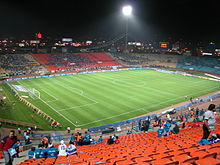
Football (soccer) is the most popular and played sport in Israel. There are several football competitions ranging from local amateur to high professional level in Israel.Israel produced some great footballers, players like : Yossi Benayoun, Eyal Berkovic,Haim Revivo, Mordechai Spiegler, Avi Nimni, Eli Ohana, Alon Mizrahi, Yehoshua Glazer , and many more.
In 1964 Israel hosted and have won the Asian Nations Cup, in 1970 Hanivheret managed to qualify to the FIFA World Cup ,which is still considered the biggest achievement of the Israeli football.
Maccabi Haifa ,Maccabi Tel-Aviv,Hapoel Tel-Aviv and Beitar Jerusalem are the largest sports clubs by popularity and in terms of trophies won , often known as "Ha-Reviya ha gdola" ("the big four") , those clubs have made an impact on the international level including appearances in the group stages of the UEFA Champions League ( twice by Maccabi Haifa and once by Maccabi Tel-Aviv ) and even reaching the quarter finals of the UEFA Cup ( by Hapoel Tel-Aviv ).
Israeli highest football league is the Israeli Premier League known as Ligat Ha-Al.
Sports and physical fitness have not always been paramount in Jewish culture. Athletic prowess, which was prized by the ancient Greeks, was looked down upon as an unwelcome intrusion of Hellenistic values. Maimonides, who was both a rabbi and a physician, emphasized the importance of regular exercise in preventing illness on the authority of Hippocrates and Galen.[287] This approach received a boost in the 19th century from the physical culture campaign of Max Nordau, and in the early 20th century when the Chief Rabbi of Palestine, Abraham Isaac Kook, declared that "the body serves the soul, and only a healthy body can ensure a healthy soul".[288]
The Maccabiah Games, an Olympic-style event for Jewish athletes, was inaugurated in the 1930s, and has been held every four years since then. The most popular spectator sports in Israel today are association football and basketball.[289] .In the Seventies Israel was excluded from the 1978 Asian Games following the organizers' refusal to invite the country as a result of pressure by participating middle eastern countries. The exclusion led Israel to shift from Asia to Europe and cease competing in Asian competitions.[290] In 1994, UEFA agreed to admit Israel and all Israeli sporting organizations now compete in Europe. Ligat ha'Al is the country's premier soccer league, and Ligat HaAl is the premier basketball league.[291] Maccabi Tel Aviv B.C. has won the European championship in basketball five times.[292]
Beersheba has become a national chess center and home to many chess champions from the former Soviet Union. The city hosted the World Team Chess Championship in 2005, and chess is taught in the city's kindergartens.[293] In 2008, the Israeli chess team won the silver medal at the Chess Olympiad in Dresden, Germany.[294]
To date, Israel has won seven Olympic medals since its first win in 1992, including a gold medal in windsurfing at the 2004 Summer Olympics.[295] Israel has won over 100 gold medals in the Paralympic Games and is ranked about 15th in the all time medal count. The 1968 Summer Paralympics were hosted by Israel.[296]
See also
References and notes
| a. | ^ The Jerusalem Law states that "Jerusalem, complete and united, is the capital of Israel" and the city serves as the seat of the government, home to the President's residence, government offices, supreme court, and parliament. United Nations Security Council Resolution 478 (Aug. 20, 1980; 14–0, U.S. abstaining) declared the Jerusalem Law "null and void" and called on member states to withdraw their diplomatic missions from Jerusalem. The United Nations and all member nations refuse to accept the Jerusalem Law (see Kellerman 1993, p. 140) and maintain their embassies in other cities such as Tel Aviv, Ramat Gan, and Herzliya (see the CIA Factbook and Map of Israel). The U.S. Congress subsequently adopted the Jerusalem Embassy Act, which said that the U.S. embassy should be relocated to Jerusalem and that it should be recognized as the capital of Israel. The Palestinian Authority sees East Jerusalem as the capital of a future Palestinian state. The city's final status awaits future negotiations between Israel and the Palestinian Authority (see "Negotiating Jerusalem", University of Maryland). See Positions on Jerusalem for more information. |
Bibliography
External links
- Government
- (Hebrew) Israel Government Portal (with links to English, Arabic versions)
- (Hebrew) Prime Minister's Office, official site (with links to English, Arabic versions)
- (Hebrew) President of the State of Israel, official site (with links to English, Arabic versions)
- The Knesset, official site of Israel's parliament
- (Hebrew) The Supreme Court, official site (with links to English, Arabic versions)
- Ministry of Foreign Affairs, official site
- Ministry of Industry Trade & Labor Official Site
- Ministry of Tourism, official site
- (Hebrew) Central Bureau of Statistics, official site (with links to English, Arabic versions)
- Official political blog of Israel
- General reference
- Country Profile from BBC News
- Israel from the Encyclopædia Britannica
- "Israel". The World Factbook (2024 ed.). Central Intelligence Agency.
- Israel resources from Columbia University Libraries
- Israel at the Jewish Virtual Library
- Israel (1988) from Library of Congress Country Studies
- Israel at Curlie
- Israel at UCB Libraries GovPubs
- The State of Israel fact file at Ynetnews
- Maps
 Wikimedia Atlas of Israel
Wikimedia Atlas of Israel- Israel-Palestine in Maps from hWeb
- Map of Israel 2008 (C.I.A./Univ. of Texas, Austin)
- Media
- Ynet News, based in Tel Aviv
- The Jerusalem Post
- HaAretz
- Israel Broadcasting Authority, state broadcasting network (in Hebrew) (with link to English version)
- Israel National News
- Kol Israel Voice of Israel
- Other
















